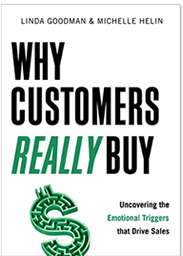Part 2: Get What You Want From People Who Don’t Want To Give It To You

“You thought you understood them fairly well. You read their answers on market-research forms and peered at them in focus groups through one-way mirrors. When they said they were “satisfied” or ‘very satisfied’ you went to bed happy at night. Why then did they defect, one by one, to your competitors?… If you are asking yourself these kinds of questions, you are part of a crowd. Unable to fathom what really motivates their customers, more and more companies are failing their central mission of pleasing the people who matter the most.”
So begins a Fortune Magazine article that extols the virtues of storytelling as it describes the problem confronting companies across the spectrum when they rely on research methodologies of the past. It continues:
“Surely there must be a better way. Wise heads … advocate far more probing research than ever before, advising companies to elicit real-life stories from customers…”
At the heart of this dilemma are the inherent risks associated with relying exclusively on traditional approaches to customer research.
As we covered in Why Conventional Market Research Isn’t Enough, surveys consist of structured questions with pre-determined response options that assume in advance the validity of that particular set of questions. If the assumptions are wrong or phrased in a way that slants the response, the findings will be misleading. Focus groups are also flawed because the group dynamic often inhibits what opinions those in attendance are willing to express or what they will share about themselves. And, while in-depth interviews present the best opportunity to truly connect with your customers, the most common format consists of a prepared discussion guide driven by a fixed notion of what the topics should be and how best to broach them. Participants, even if so inclined, have little flexibility to express themselves in candid and unexpected ways.
Get Better In-Depth Interview Results by Breaking the Mold!
When customers, whether they are consumers or business clients, agree to participate in an in-depth interview, they usually have a good idea of what they’ll be asked. They also have time to decide exactly what they will and won’t reveal. Since discussion guides based on direct questions tend to be predictable, customers have an advance opportunity to craft an explanation for their behavior and/or opinions. It’s typically a rationale after the fact. As a result, their “spin” is a combination of part truth, part wishful thinking, and, part reinvention.
If you want to change the results, be disruptive. Regard formal in-depth discussion guides with skepticism. Instead of searching for specific answers, concentrate broadly on the types of insights you want to uncover. Through a combination of intriguing questions and skillful prompts, allow your customers to take the lead. Inevitably they will steer you to the right solutions if you know how to listen. Really listen.
Step #1: Toss the Prepared Discussion Guide
Prepared discussion guides seek to map reactions to existing products, services or the company itself based on internally held assumptions. It’s an inside-out approach that elicits responses to a circumscribed set of inquiries that may have little to do with what matters most to your customers or explain what shapes their opinions and drives their behavior.
Step #2: Adopt an Outside-In Approach
The most valuable in-depth interviews are about more than your customers’ opinions of existing products and services or their theoretical responses to a hypothesis posed to them. The objective should be to gain a nuanced grasp of what your customers really want or need, the reasons why, the best way to engage them, and, how to forge lasting relationships. Focus on digging for genuine insights rather than answers by encouraging an interaction free of pre-existing assumptions.
Step #3: Embrace the Power of Emotion
The motivations customers act on are seldom logical, predictable, or even conscious. Instead, their strongest responses stem from one source: emotion. Regardless of whether your customers are consumers or other businesses all customers are people. And people are emotional beings. It’s a deceptively simple reality that changes the way your company must go about understanding your customers. It requires finding ways to transcend what they say in order to uncover what they really mean.
Step #4: Surprise Your Customers to Encourage Storytelling
Substitute a formal discussion guide for an indirect approach that features provocative open-ended questions. The length of the conversation, combined with an unexpected and disarming approach circumvents customers’ predictable answers and exposes the hidden reasons behind their actions, beliefs or convictions.
Provocative open-ended questions engage customers in a non-threatening way. More to the point, when asked the unexpected, customers have no ready answers. Consequently their unplanned responses are more revealing and provide the most authentic window into the emotional triggers that explain their actions.
Indirect questions result in richer conversations that often take unforeseen but productive turns. Provocative open-ended questions paired with insightful listening and bias-free notions will take you on a journey of discovery. When you follow the customer’s lead you may not always know where you’re headed but the surprising twists and turns along the way often expose the most valuable insights.
Step #5: Disarm and Engage
Encourage customers to speak in narratives by beginning with a provocative open-ended question. Most people spend the first twenty minutes of any exchange giving stock and standard answers. They respond in ways intended to make them look good or appear smart. This technique immediately breaks down those barriers and jumpstarts a more productive conversation. The emotional triggers your company must understand to solve complex problems are revealed through the stories participants instinctively share.
A company seeking to do more business with a consumer product manufacturer might ask the EVP of sales:
If you found yourself at a cocktail party sharing “war stories” with other industry executives about your competitive nightmares in local markets, what single incident would you be most likely to talk about? Why?
A Lawn & Garden chain seeking to increase sales of recreational and discretionary outdoor purchases might ask:
When you think about some of the best times you’ve ever had in your outdoor space or some of the best memories you have of using that outdoor space, what are they? Describe them to me.
A B2B organization seeking to strengthen customer relationships and solidify long term retention might ask:
Tell me the story of how your ideal partner today first earned your trust. How did that make you feel?
Employ follow-up prompts such as those below to encourage participants to enhance their narrative in greater detail before moving on to the next open-ended question. Depending upon the situation you might probe with:
- What have you learned?
- How did that make you feel?
- If you had it to do to over, how would you handle that situation differently?
Capitalizing on Emotional Triggers
Emotional Trigger Research is a tool that arms companies with actionable intelligence by delivering the hard edges to vague or misleading findings. Sometimes companies have several pieces of the puzzle. But because they don’t understand their customers’ emotional triggers they lack the subtle nuances needed to put the pieces together in ways that equip them to craft the right strategies and execute them most effectively.
Let’s explore two examples:
Example #1: Jumpstarting Sales
An automotive aftermarket chain experienced weak sales in their most profitable category: private label tires. According to the manufacturer’s tests, the quality and performance were comparable to the major nationally recognized brands. And since these tires sold for twenty to thirty percent less, the company was convinced the price differential was their competitive advantage and made it the focus of their marketing efforts.
It turned out customers were suspicious of the manufacturer’s test results believing there was an inherent conflict of interest. When they bought tires, the safety of their families was a top priority. Because of the potentially serious consequences of driving on poor quality tires, price was not the determining factor. They were motivated by love. Peace of mind was the emotional trigger than unlocked the mystery of this underperforming category.
The solution was to retain a highly regarded and well known independent testing facility to validate the tires quality and performance comparability to the leading brands. Once armed with legitimate proof, the findings provided the ammunition to launch a successful marketing and sales initiative.
Example #2: Rebranding to Win More Business
An online auction site for surplus oil and gas industry equipment had gone from a start-up to a $25 million business within five years. Up to that point oil and gas companies had a decentralized approach to disposing of surplus equipment. Transaction records were spotty. Then Sarbanes-Oxley became law and suddenly CFO’s, who had the responsibility for inventory management, were required under penalty of corporate fines and criminal charges to accurately report on the value of all company assets.
But many didn’t know how to go about changing a decentralized corporate culture as quickly as the law demanded. These corporate executives were overwhelmed and frightened. When Emotional Trigger Research revealed the depth of anxiety CFO’s were experiencing it opened the door for the online auction site to rebrand their company from just a service provider to a Sarbanes-Oxley turnkey solution consultant and resource as well. By doing so, they were able to elevate the level of their client contact from lower level employees to senior management and win more business from existing accounts.
Within two years the online auction site doubled their sales.
The key to success in today’s economy is understanding your customers at the deepest level. Are YOU prepared?





